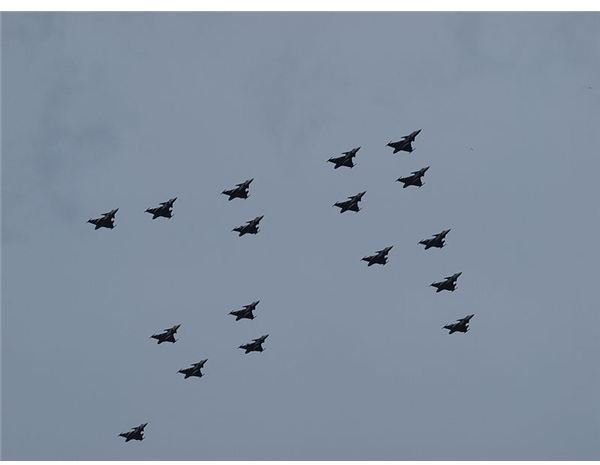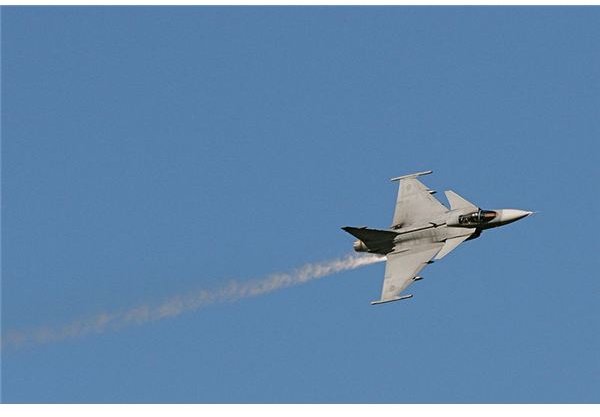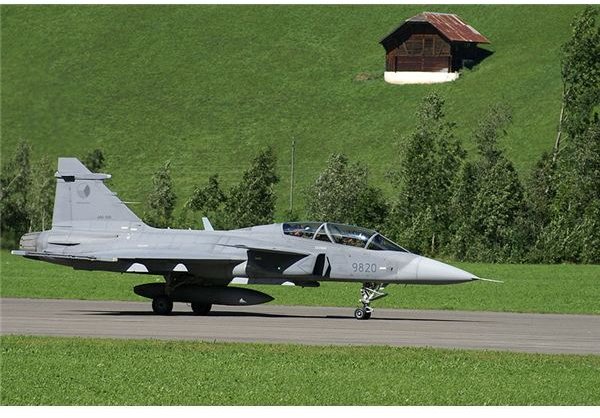Gripen NG - The Sea Gripen 39 Updated for the 21st Century
Gripen NG: Competing with the Rafale and Eurofighter
The deployment of the first Gripens in the 1990 has given the aircraft a multi-year head start over any other generation 4+ aircraft when it comes to making its case for its low costs of operation and excellent safety record. Unfortunately, being an early adopter in aviation means that any subsequently developed aircraft offered by a rival can immediately be made superior in terms of avionics and performance.
The Gripen NG is Saab’s answer to the development of the Rafale and Eurofighter. Both are heavier aircraft and less maneuverable, but both incorporate cutting edge avionics and native support for advanced AESA radar sets - advantages not easily overlooked when a combat aircraft aircraft is being marketed to up and coming military powers.
Gripen NG technical specifications also confront the Eurofighter and Rafale aircraft in an area where the standard Gripen is lacking relative to its European competitors: range. While light and nimble, the base model Gripen also has a shorter range than either contemporary fighter.
Gripen NG - Standard Gripen Comparisons
Though the Gripen NG has not yet entered service, the prototype, specifications, and technology demonstrator have all indicated the direction the upgrade will take. When compared to the standard Gripen, the update will be heavier, have better range, and superior technology to its predecessor.
The inclusion of the AESA array is one of the major selling points of the Gripen NG. A powerful variant of standard radar, AESA is a phased array radar system that broadcasts radar waves in a manner that decreases the probability that the radar transmission will be detected and traced back to its source. This allows an AESA equipped aircraft to be stealthier, lowering the danger inherent in using active sensors.
The Gripen NG is expected to be roughly 1/7 larger than the original Gripen, going from 7 tons to 8 tons max takeoff weight. A restructuring of the landing gear arrangement within the fuselage allows the updated Gripen to carry nearly 50 percent more fuel as before, and its expected combat radius will be well over 1000km with half a dozen air to air missiles and drop tanks providing extra range and a 30 minute loiter time.

Finally, the Gripen NG is anticipated to boast supercruise, which will allow it to exceed the speed of sound without using its afterburners. This capability, native to the Eurofighter and American F-22, is a strong selling point for the new Gripen.
Gripen NG Against the Rafale
In truth, it is unlikely that the Gripen NG’s updated capabilities are intended to go toe to toe with the Typhoon. Eurofighters are far larger and far more expensive than the Gripen - much closer to an F-22 than a lightweight fighter could ever hope to be. Aside from the Indian M-MRCA competition, the Gripen isn’t generally pitted against the Eurofighter in the export markets.
The Rafale is another story, however. In Brazil and India the Gripen and Rafale are direct competitors because both of the aircraft are relatively lightweight, not built by as massive a consortium as is the Eurofighter, and fairly inexpensive. The Gripen NG is clearly intended to evolve the airframe beyond that of the Dassault Rafale, and the combination of the Gripen’s high maneuverability, extreme deployability, and low operating costs make it a compelling choice for air forces considering the Rafale or Gripen for their next generation combat aircraft.
A New Tact - The Sea Gripen 39

Possibly the best example of the Saab Gripen’s long term orientation as a competitor to the Rafale is seen in the proposed naval variant of the Gripen, generally known as the Sea Gripen. 39 is at times attached to this nomenclature to re-emphasize that the Gripen, even in a navalized variant, still shares the same basic characteristics as the standard JAS 39 Gripen fighter aircraft.
The Sea Gripen 39 project was first considered back in the 1990’s, when Saab was considering all its options to maximize the export potential associated with the Gripen. But with the increasing demand for carrier based aviation from rising naval powers such as India and Brazil, the project was given a second look, and given the go ahead in 2009.
Sea Gripen 39: Gripens At Sea
The navalized Gripen that has been proposed is intended to take advantage of the increased size and combat capability accorded to the aircraft under the Gripen NG project. The Sea Gripen 39 would effectively be an NG generation Gripen with structural and equipment upgrades that would allow the fighter to operate from a carrier deck.
There is clearly a major risk in any navalized Gripen project: taking an aircraft originally designed to operate from land and then just tweaking it so that it also functions as a naval aircraft is a complex endeavor. The Russians took the basic airframe of the SU-27 Flanker and navalized it, but the changes were significant enough that they named the new fighter the SU-33. The MiG-29K is also a navalized variant of the well known Russian fighter and is operated by India, but the fact that India is already looking for a replacement indicates that there have been problems.
Fortunately for Saab, the Gripen has several features endemic to the design that make a potential Sea Gripen 39 project more feasible. The aircraft is fairly small to start, and quite light. In fact, its about half the weight of an F-18 Hornet, a US fighter which has successfully operated from US carriers since the 1980’s. It is also a small airframe, and was designed from the outset to fly from poorly prepared airstrips and even highways, taking off in very short distances. In all likelihood the Sea Gripen would be meant to fly from carriers both with catapults and with ski jump decks, and unlike the Rafale could very well manage the latter given a sufficient redesign.
Sea Gripen: Verdict
While unconventional to take an airframe that has been in service for a decade and propose making such a radical modification, the Sea Gripen 39 concept has quite a bit going for it. Small size, advanced technology, and the updates inherent in the NG model of the Gripen all give the possible Sea Gripen variant hope for success.
But challenges will be significant. Sweden does not have experience constructing carrier aircraft, and the Rafale is already proven to be carrier capable, and even inter-operable with US Naval air wings.

The Gripen also has a lesser weapons load than the Rafale, which means that its capabilities will rely on small numbers of highly precise weapons.
But with its low operating costs and Saab’s proven ability to innovate, the possibility of seeing Sea Gripen 39 fighters flying from Brazilian or Indian carrier decks should not be discounted.
Gripen International: Gripen Demonstrator - The Future Has Arrived!, 2008
Flight Global: Saab Reveals Gripen Demo Aircraft, 2008
Stratpost: Saab Offers Naval Gripen to India, 2009
This post is part of the series: The Saab Gripen Fighter: Multiple Variants and Export Oriented
The JAS 39 Gripen by Saab was one of the first generation 4+ combat aircraft, and since its debut it has proven to be a highly cost effective lightweight fighter. In the service of several air forces including its native Sweden, major next generation aircraft competitions feature the Gripen
